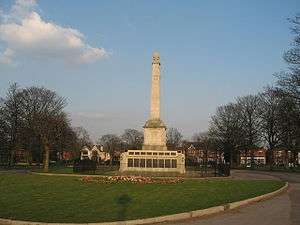Widnes War Memorial

Widnes War Memorial stands in Victoria Park, Widnes, Cheshire, England. It commemorates the serving men who lost their lives in the two world wars. The memorial consists of an obelisk in Portland stone on a plinth of York stone. It was unveiled in 1921, and more names were added in 1950. The monument is recorded in the National Heritage List for England as a designated Grade II listed building.
History
Widnes Borough Council commissioned a memorial in 1920 to commemorate the citizens of the town who fell in the First World War. Following a competition the design of Harold E. Davies was selected, and Herbert Tyson Smith was appointed as the sculptor. The building contractors were Messrs. Stewart Jones of Liverpool. The foundation stone was laid on 28 August 1920, and the memorial was unveiled on 28 September 1921. This ceremony included a procession from the Town Hall led by the mayor and the 17th Earl of Derby. The memorial was paid for by public subscription which raised £7,830, against a target of £10,000. However the memorial cost only £6,000, and the remainder was used as a social fund towards the poor of the town.[1] An inscription and plaques were added to commemorate those lost in the Second World War, and these were unveiled in April 1950.[2]
Description
The memorial consists of an obelisk in Portland stone standing on a stepped plinth in York stone. The obelisk is about 12.8 metres (42 ft) high on a plinth about 2.1 metres (7 ft) in height. Around the plinth are 30 bronze tablets inscribed with the names of the 818 men who died in the First World War. On the base of the obelisk is the coat of arms of Widnes. At the top of the obelisk is a flaming urn to symbolise immortality.[1] The corners of the plinth are angled and contain carved laurel wreathes. Higher in the plinth are eight bronze tablets with the names of those lost in the Second World War. Towards the top of the obelisk on all four faces are crosses carved in relief. Below the crosses on the north and south sides are palm branches, and below those on the east and west sides are laurel wreathes.[2]
In a panel on the front (south) side of the plinth is an inscription reading as follows.[1][2]
- ERECTED BY THE CITIZENS
- OF THE BOROUGH OF WIDNES
- IN COMMEMORATION OF THE
- MEN OF THIS PLACE WHO MADE
- THE SUPREME SACRIFICE IN
- THE GREAT WAR OF 1914 – 1919
- THIS FOUNDATION STONE WAS
- LAID 28TH AUGUST 1920 BY
- ALDERMAN EDWIN WOOD – MAYOR
On the same face, above the smaller plaques, is an inscription reading as follows.[1][2]
- IN MEMORY OF THE MEN OF WIDNES WHO GAVE THEIR LIVES
- 1939 – 1945
- UNVEILED BY ALDERMAN T SWALE MAYOR 12TH APRIL 1950
On the front of the base of the obelisk is an inscription reading:[1][2]
- THIS MEMORIAL WAS UNVEILED
- SEPTEMBER 28TH 1921 BY THE
- RIGHT HON THE EARL OF DERBY KG
On the left (west) side the inscription reads:[1][2]
- TO OUR
- GLORIOUS
- DEAD
- 1914 – 1919
- 1939 – 1945
On the right side the inscription is:[1][2]
- THE BLOOD
- OF HEROES
- IS THE SEED
- OF FREEDOM
And at the back is inscribed:[1][2]
- THEIR NAME
- LIVETH FOR
- EVERMORE
Appraisal
The monument was designated as a Grade II listed building on 21 August 2007.[2] Grade II is the lowest of the three grades of listing and is applied to "buildings of national importance and special interest".[3] In the citation for listing it is described as being "intricately carved and highly imposing", it incorporates "symbolic imagery" and "richly detailed carvings", making it a "striking and prominent architectural feature".[2] Pollard and Pevsner in the Buildings of England series describe it as being "impressive and dignified".[4]
See also
References
- 1 2 3 4 5 6 7 8 Morris, Edward; Roberts, Emma (2012), Public Sculpture of Cheshire and Merseyside (excluding Liverpool), Public Sculpture of Britain, 15, Liverpool: Liverpool University Press, pp. 250–251, ISBN 978-1-84631-492-6
- 1 2 3 4 5 6 7 8 9 10 Historic England, "War Memorial. Victoria Park, Widnes (1392210)", National Heritage List for England, retrieved 9 January 2014
- ↑ Listed Buildings, Historic England, retrieved 12 April 2015
- ↑ Pollard, Richard; Pevsner, Nikolaus (2006), Lancashire: Liverpool and the South-West, The Buildings of England, New Haven and London: Yale University Press, p. 653, ISBN 0-300-10910-5
Coordinates: 53°22′28″N 2°43′49″W / 53.37454°N 2.73039°W